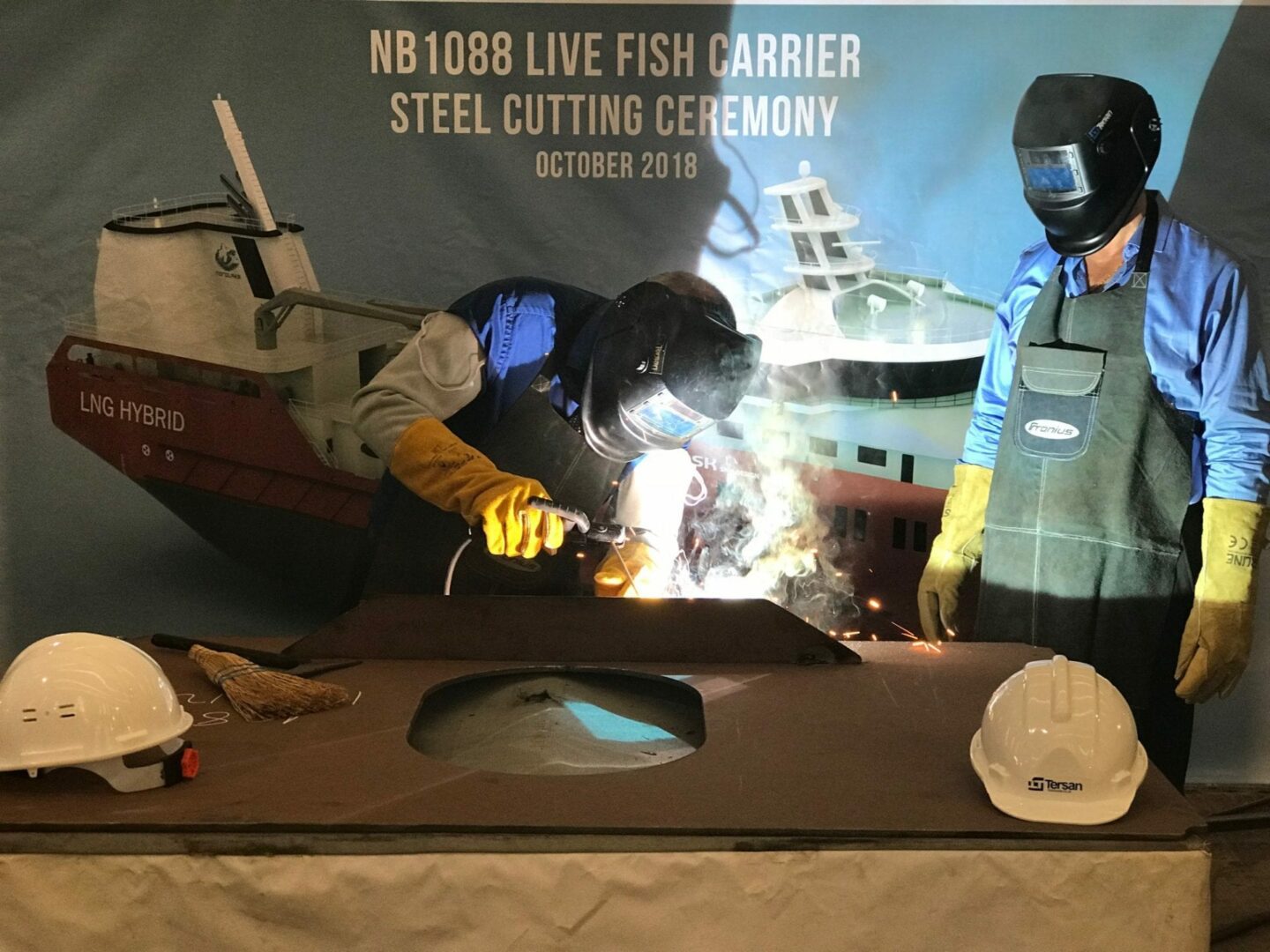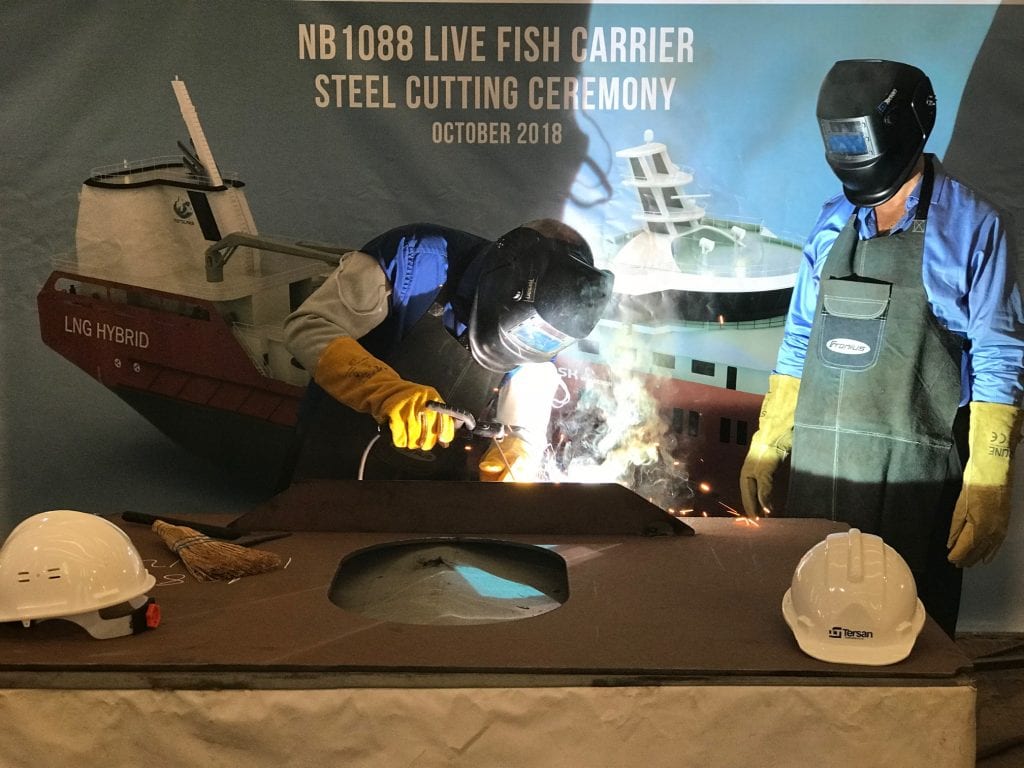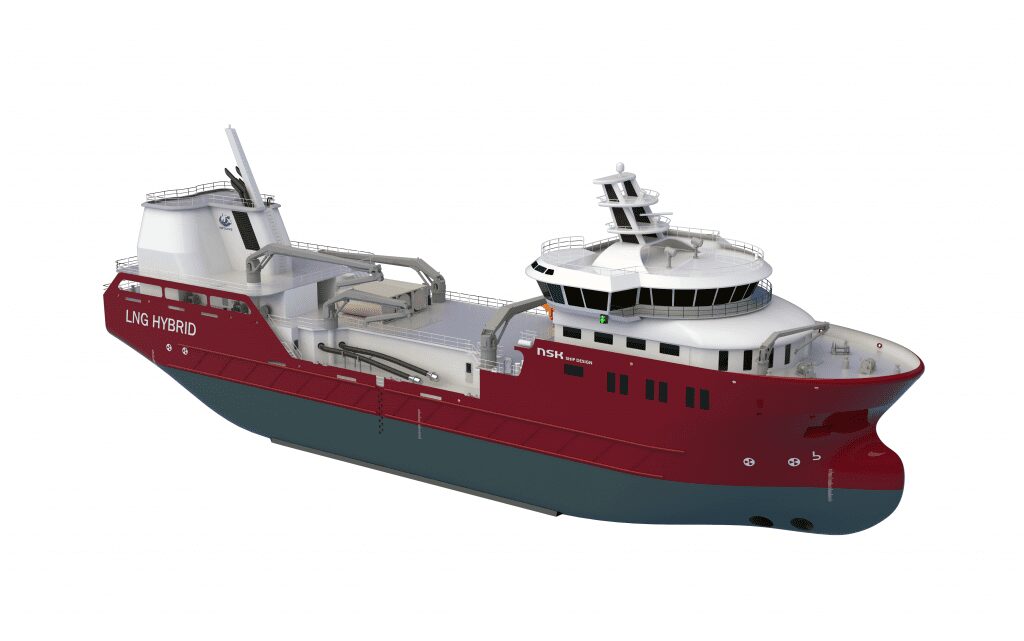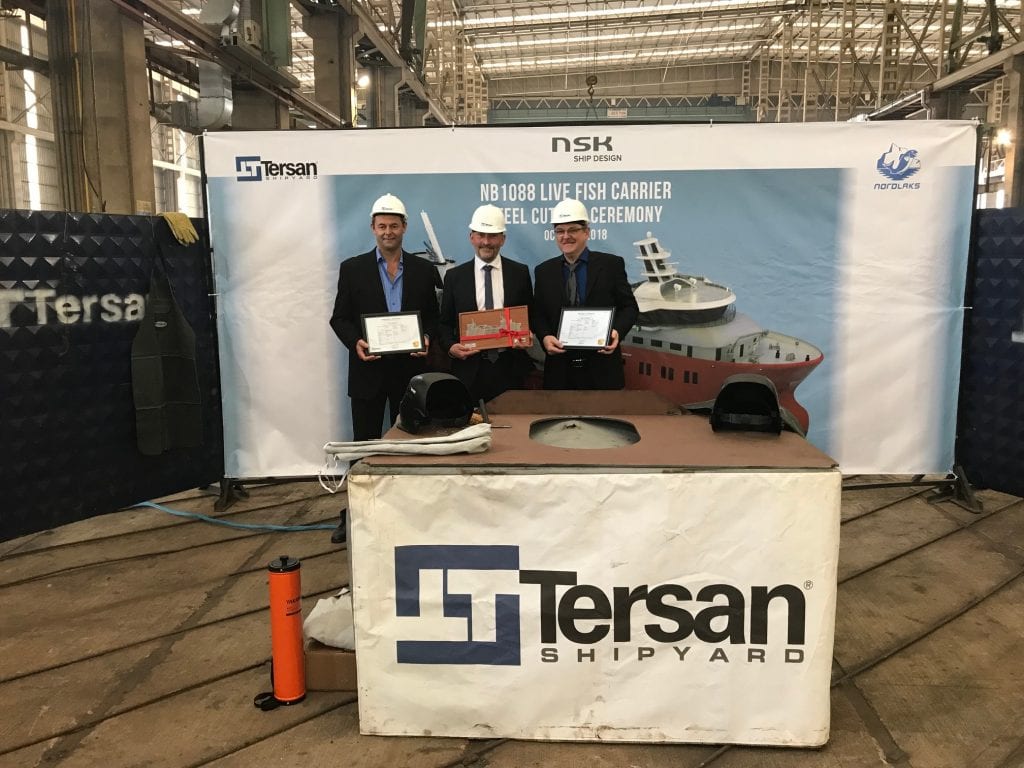
Nordlaks is ordering another live fish carrier with gas / battery hybrid propulsion, to reduce the diesel consumption for transporting live fish from 2020. The first live fish carrier is already under construction. Vessel number two originates from the same design by NSK Ship Design.

FV: Captain Per Tore Paulsen and Machine Chief Svein Arild Jakobsen got the credit of welding the first hull parts to the first of two new live fish carriers (October 16, 2018).
“Technology development means that we get to choose out of range of solutions the ones that can be efficient both for the environment and the business at the same time. Another example is the use of electricity at our fish farms, where we already have turned off the diesel generators at 29 of our 39 farms, and in 2019 additional six new fish farms will be connected to the electrical power grid.
With the transition to liquefied natural gas and shore power also for the live fish carriers, the conversion to more environmentally friendly energy sources is becoming substantial”, says CEO Erik Welde in Nordlaks.
The ongoing debate in Norway about potential environmental impact from current methods used to fight sea lice, are additional reasons why Nordlaks decided to purchase two new live fish carriers.
“We foresee a future where removal of sea lice from the fish will happen in closed containment systems aboard boats, and it is highly important for us to have access to the required capacity and to keep control of the process ourselves. The investments give us enough room to follow up the principle of precautionary approach, “Welde said.
In cooperation with NSK Ship Design, the Norwegian NOx Fund and governmental funding agency Enova, Nordlaks have chosen to invest in liquefied natural gas (LNG) as an energy source for the live fish carriers, also accompanied with a large battery pack and a shore electrical power connection.
The use of battery packs, shore power and LED lights will alone save the environment 1 864 tonnes of CO2 per year, by each of the two new live fish carriers. The governmental funding agency Enova supports the project with more than 3.1 million kroner.
“Enova is working for new energy and climate technologies to be developed and put in place so Norway can become a low-emission society. This relies on players like Nordlaks who are willing to lead the way. Battery solutions at sea are one of the necessary changes we must see in the transport sector, whilst the aquaculture industry also has a great potential for cutting diesel consumption. The lessons learned by Nordlaks will make it easier for others in the industry to follow, says Øyvind Leistad, Marketing and Development Director in Enova.
In addition, the use of gas engines will give a 30 percent reduction in CO2 emissions compared to a traditional diesel engine, because a gas engine utilizes the energy in the fuel more efficiently. The use of liquefied natural gas will also provide a 90 percent reduction of the emissions of the NOx.
“The industry’s own funding agency, the Norwegian NOx fund, supports well boat number two with up to 56 million kroner. The substantial support is based on the large NOx reduction that the vessel achieves by converting from diesel to LNG. The emission cut is estimated at 136,000 kg NOx. It is equivalent to NOx emissions from approximately 85,000 new diesel cars with EURO 6 emission standards. With the new live fish carriers, Nordlaks becomes a pioneer in their ship segment. We have encouraged the use of gas engines for live fish carriers and hope for more companies to learn from this experience and to follow up, “says Tommy Johnsen, Managing Director of the NOx Fund.

Illustration of NSK4126 / NB1088. Illustration: NSK Ship Design

Illustration of NSK4126 / NB1088. Illustration: NSK Ship Design
Both vessels are designed by NSK Ship Design in Harstad and built by Tersan Shipyard in Turkey.
“It is, of course, a great day for us when Nordlaks now reports that they have ordered another boat of our design NSK4126. We are confident in the concept of a clean LNG / battery solution, which also reduces fuel costs compared with the use of traditional live fish carriers, “says Thomas Myhre, Marketing Manager at NSK Ship Design.
On the 17th of October Nordlaks, NSK Ship Design and Tersan Shipyard held the steel cutting ceremony for NSK4126 / NB1088, the preliminary and somewhat cryptic term of the first of Nordlaks’ two new live fish carriers. The second ship is expected to be delivered in 2021.
In September, Nordlaks announced the sale of the live fish carrier “Bjørg Pauline” to the company Intership Nord. The purhase of an additional live fish carrier does not affect the “time charter” agreement entered into with Intership Nord in connection with the sale.

FV: Captain Per Tore Paulsen, well-boatman Kurt Werner Nilsen and engineer Svein Arild Jakobsen, all in Nordlaks, behind the visible evidence that the construction of the first of two new live fish carriers to Nordlaks has begun (October 16, 2018).
–END–
Contacts:
Sales and Marketing Manager Thomas Myhre, NSK Ship Design, thomas.myhre@nsk.as
Press contact Lars Fredrik Martinussen, Nordlaks, lfm@nordlaks.no
Facts about the live fish carriers – by NSK Ship Design:
- By using land flow, battery pack and LED lighting, Nordlaks’s CO2 emissions per live fish carrier reduces by 1864 tonnes per year.
- By using liquefied natural gas (LNG) as an energy carrier, vessels will cut particulate emissions into air.
- 30% reduction of CO2 emissions (in addition to the reduction associated with land flow, battery and LED lights).
- 90% reduction of NOx emissions
- The design is purely gas-electric (liquefied natural gas, LNG), and with absolutely no diesel on board – neither for propulsion nor for power generation.
- Live fish carriers are optimized for operation at exposed areas.
- The vessels are built at Tersan Ship Yard in Turkey and are expected to be delivered 2020 and 2021 respectively.